Technology reporter
 Google
GoogleTwenty -five years ago, computer programmers were competing to fix the millennium’s mistake in the midst of fear that it would make the banking systems crash and planes fall from the sky.
Too much for the relief of all The impact turned out to be minimal.
Today, some are afraid that there is a new critical threat to digital infrastructure in the world. But this time, we cannot predict exactly when it will move from theory to reality, while the ubiquitousness of digital technology means regulating the problem is even more complicated.
This is because the advent of quantum computing means that many of the encryption algorithms that support and provide our hyperconnected world will be trivially easy to hit.
Quantum calculation is radically different from the “classic” computing used today. Instead of processing binary parts that exist in one of the two states – one or zero, in or out – quantum calculation uses Qubits, which may exist in multiple countries, or overlap.
“The reason why it is so powerful is because you are doing all those possible calculations at the same time,” explains Prof Nisanth Sastry, director of computers’ science at the University of Surrey. This means that it is “very, much more efficient, much, much more powerful.”
This means that quantum systems offer the possibility of solving major problems that are beyond classic computers, are areas such as medical research and material science, or cracking of particularly complex mathematical problems.
The problem is some of those the same mathematical problems support the encryption algorithms that help to provide confidence, confidentiality and intimacy in today’s computer networks.
Today’s computers would take thousands, even millions of years, to hit current encryption standards, such as RSA. A convenient quantum computer, theoretically, can do the job in minutes.
This has implications for everything, from electronic payment and e -commerce to satellite communications. “Everything that is protected by something that is tangible becomes a fair game for people who have access to the respective quantum computers,” says Jon France, the leading information officer in the non -profit security organization on the ISC2 Internet.
Quantum computers capable of breaking asymmetric encryption are thought to be years away.
But progress is taking place.
In December, Google said its new quantum chip Includes the main “advances” and “paves the way to a useful, large -scale quantum computer”.
Some estimates say a quantum device capable of breaking current encryption would require 10,000 Qubits, while others say it would take millions. Today’s systems have several hundred most.
But businesses and governments face a problem now, as attackers could reap coded information and decipher it later when they gain access to appropriate equipment.
 Google
GoogleGreg Wetmore, Vice President for Software Development at the Estust Security Firm, says that if such devices can appear in the next decade, technology executives should ask, “which data in your organization are valid for that period? “
This can be national security information, personal data, strategic plans and intellectual property and secrets – think about the “secret” formula of a soft drink company or the exact balance of plants and spices in a fast food recipe.
Mr. France adds, if quantum calculation becomes widespread, the threat becomes more immediate with the encryption that protects our daily banking transactions, for example, potentially irrelevant to break.
The good news is that researchers and technology industry have worked on solving the problem. In August, the National Institute of Standards and Technology at the US issued three quantum standards of quantum encryption.
The agency said these would “provide a wide range of electronic information, from confidential email messages to e -commerce transactions that push the modern economy.” It is by encouraging computer system administrators to move to new standards as soon as possible, and said that 18 more algorithms are being assessed as reserve standards.
 Getty Images
Getty ImagesThe problem is that this means a massive update process that practically affects all our technology infrastructure.
“If you think about the number of things there with asymmetrical encryption in them, there are billions of things. We’re facing a really big difference problem,” says Mr. France.
Some digital infrastructure will be relatively easy to improve. Your browser, for example, will simply receive an update from the seller says Mr. France. “The challenge really comes to discrete equipment and the internet of things (IOT),” he continues.
These can be difficult to find, and geographically inaccessible. Some devices – inheritance devices in national critical infrastructure such as water systems, for example – may not be powerful enough to treat new encryption standards.
Mr. Wetmore says the industry has managed the transitions of encryption in the past, but “is the sharpest interruption that makes this threat more serious.”
So it is trying to help clients build “cryptocurrency version” by setting policies now and using automation to identify and manage their cryptographic assets. “This is the secret to making this transition a regular and not a chaotic.”
And the challenge lies in space. Prof Sastry says many satellites – such as the Starlink Network – must be relatively direct to improve, even if it means to briefly get an individual device temporarily temporarily.
“At any given moment in time, especially with leo satellites (lower earth orbit), you have 10 to 20 satellites on your head,” says Prof. Sastry. “So if someone can’t serve you, well, what? There are nine others that can serve you. “
More challenging, he says, are “distant sensors” satellites, which include those used for geographical or intelligence purposes. These hold much more calculators on board and usually include a kind of secure computing module. A hardware update effectively means replacing the entire device. However, says Prof Sastry, this is now less a problem thanks to the most frequent and lower cost satellite omissions.
While the impact of the millennium’s mistake may have been minimal in the early days of 2000, because a large amount of work had gone to his arrangement ahead of a well -known deadline, says François Dupressoir, a professor associated with cryptography in University of Bristol.
In contrast, he adds that it is not possible to predict when the actual encryption will become tangible.
“With cryptography,” says Mr.
